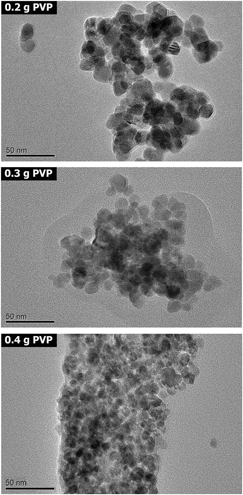Crossref Citations
This article has been cited by the following publications. This list is generated based on data provided by
Crossref.
Vatsha, Banele
Tetyana, Phumlani
Shumbula, Poslet Morgan
Ngila, Jane Catherine
Sikhwivhilu, Lucky Mashudu
and
Moutloali, Richard Motlhaletsi
2013.
Effects of Precipitation Temperature on Nanoparticle Surface Area and Antibacterial Behaviour of Mg(OH)<sub>2</sub> and MgO Nanoparticles.
Journal of Biomaterials and Nanobiotechnology,
Vol. 04,
Issue. 04,
p.
365.
Inamdar, Yusuf
Beedri, Niyamat
Kodam, Kisan
Shaikh, Arif
and
Pathan, Habib
2015.
Aggregation of ZnO Nanocrystallites Using Polyol Process for Dye (Reactive Red) Sensitized Solar Cell.
Macromolecular Symposia,
Vol. 347,
Issue. 1,
p.
52.
Altintas Yildirim, Ozlem
Liu, Yuzi
and
Petford-Long, Amanda K.
2015.
Synthesis of uniformly distributed single- and double-sided zinc oxide (ZnO) nanocombs.
Journal of Crystal Growth,
Vol. 430,
Issue. ,
p.
34.
John Sushma, N.
Prathyusha, D.
Swathi, G.
Madhavi, T.
Deva Prasad Raju, B.
Mallikarjuna, K.
and
Kim, Hak-Sung
2016.
Facile approach to synthesize magnesium oxide nanoparticles by using Clitoria ternatea—characterization and in vitro antioxidant studies.
Applied Nanoscience,
Vol. 6,
Issue. 3,
p.
437.
Chithra, Maruthanayagam Jay
and
Pushpanathan, Kuppusamy
2016.
Thermal, structural and optical investigation of Cu-doped ZnO nanoparticles.
Modern Physics Letters B,
Vol. 30,
Issue. 34,
p.
1650406.
Mohamed Isa, E D
Che Jusoh, N W
Hazan, R
and
Shameli, K
2020.
Pullulan mediated zinc oxide microparticles: Effect of synthesis temperature.
IOP Conference Series: Materials Science and Engineering,
Vol. 808,
Issue. 1,
p.
012032.
Lin, Chia-Chang
and
You, Yi-Cheng
2020.
Mass-production of ZnO nanoparticles by precipitation in a rotating packed bed: effect of zinc salt.
Journal of Materials Research and Technology,
Vol. 9,
Issue. 4,
p.
8451.
Ahammed, Kazi Rakib
Ashaduzzaman, Md.
Paul, Shujit Chandra
Nath, Mithun Rani
Bhowmik, Snahasish
Saha, Otun
Rahaman, Md. Mizanur
Bhowmik, Shukanta
and
Aka, Tutun Das
2020.
Microwave assisted synthesis of zinc oxide (ZnO) nanoparticles in a noble approach: utilization for antibacterial and photocatalytic activity.
SN Applied Sciences,
Vol. 2,
Issue. 5,
Goncalves, Nuno P.F.
Lourenço, Mirtha A. O.
Baleuri, Simone R.
Bianco, Stefano
Jagdale, Pravin
and
Calza, Paola
2021.
Biochar Waste-Based ZnO Materials as Highly Efficient Photocatalysts for Water Treatment.
SSRN Electronic Journal ,
Rathnasekara, Rusiri
and
Hari, Parameswar
2021.
Impedance spectroscopy of nanostructured ZnO morphologies.
Journal of Materials Research,
Vol. 36,
Issue. 9,
p.
1937.
Naserian, Farzaneh
and
Mesgar, Abdorreza S.
2022.
Development of antibacterial and superabsorbent wound composite sponges containing carboxymethyl cellulose/gelatin/Cu-doped ZnO nanoparticles.
Colloids and Surfaces B: Biointerfaces,
Vol. 218,
Issue. ,
p.
112729.
Liu, Hai-Quan
Yao, Cheng-Bao
Cai, Yu
and
Yin, Hai-Tao
2022.
Synthesis, photoluminescence and photocatalytic characteristics of Ag–ZnO sandwich structures.
Journal of Physics and Chemistry of Solids,
Vol. 165,
Issue. ,
p.
110697.
Gonçalves, Nuno P.F.
Lourenço, Mirtha A.O.
Baleuri, Simone R.
Bianco, Stefano
Jagdale, Pravin
and
Calza, Paola
2022.
Biochar waste-based ZnO materials as highly efficient photocatalysts for water treatment.
Journal of Environmental Chemical Engineering,
Vol. 10,
Issue. 2,
p.
107256.
Ahmad, Ahmad A.
Alsaad, Ahmad M.
Aljarrah, Ihsan A.
Al-Bataineh, Qais M.
and
Telfah, Ahmad D.
2022.
Optical, electronic, and structural properties of different nanostructured ZnO morphologies.
The European Physical Journal Plus,
Vol. 137,
Issue. 6,
Muñoz-Fernandez, L.
Gomez-Villalba, L.S.
Milošević, O.
and
Rabanal, M.E.
2022.
Influence of nanoscale defects on the improvement of photocatalytic activity of Ag/ZnO.
Materials Characterization,
Vol. 185,
Issue. ,
p.
111718.
Jang, Suyoung
Karade, Vijay
Jang, Jun Sung
Jo, Eunae
Shim, Hongjae
Kim, Su Gil
Patil, Komal
GOUR, KULDEEP SINGH
and
Kim, Jin Hyeok
2022.
Achieving Over 10% Device Efficiency in Cu2znsn(S,Se)4 Thin-Film Solar Cells with Modifications of Window Layer Properties.
SSRN Electronic Journal ,
Wang, Li-Yuan
Shi, Bing-Yin
Yao, Cheng-Bao
Wang, Ze-Miao
Wang, Xue
Jiang, Cai-Hong
Feng, Li-Feng
and
Song, Ying-Lin
2023.
Size and Morphology Modulation in ZnO Nanostructures for Nonlinear Optical Applications: A Review.
ACS Applied Nano Materials,
Vol. 6,
Issue. 12,
p.
9975.
Jang, Suyoung
Karade, Vijay C.
Jang, Jun Sung
Jo, Eunae
Shim, Hongjae
Kim, Su Gil
Patil, Komal
Gour, Kuldeep Singh
and
Kim, Jin Hyeok
2023.
Achieving over 10% device efficiency in Cu2ZnSn(S,Se)4 thin-film solar cells with modifications of window layer properties.
Journal of Alloys and Compounds,
Vol. 930,
Issue. ,
p.
167302.
Bumbudsanpharoke, Nattinee
Nurhadi, Rineta Pertiwi
Chongcharoenyanon, Busarin
Kwon, Seongyoung
Harnkarnsujarit, Nathdanai
and
Ko, Seonghyuk
2024.
Effect of migration on the functionality of zinc oxide nanoparticle in polybutylene adipate terephthalate/thermoplastic starch films: A food simulant study.
International Journal of Biological Macromolecules,
Vol. 263,
Issue. ,
p.
130232.
